
Jessica Smolinski
A small, exquisitely carved head of a bearded god is in a glass exhibit at the Yale University Art Gallery for the first time since 1999.
The sculpture resides in the Mary and James Ottaway Gallery of Ancient Dura-Europos. Two dozen objects from this gallery were loaned to The Metropolitan Museum of Art for their exhibition titled “The World between Empires: Art and Identity in the Ancient Middle East.” When those 24 objects were returned this summer, the YUAG also requested the Met return several other objects the museum kept for years. The sculpture of the bearded god is one of these items.
“It was time to bring everything back to Yale,” Lisa Brody, the associate curator of Ancient Art at the YUAG, said.
Brody organized the Dura-Europos gallery when it was installed in 2012. She said the Met approached the YUAG in early 2018 to borrow objects from the Dura-Europos collection. The YUAG was supportive because they wanted to be a part of the exhibition and endorse the exciting and advanced scholarship, Brody said.
Blair Fowlkes-Childs, a research associate in the Met’s department of Ancient Near Eastern Art, co-curated the exhibit with Michael Seymour, an assistant curator at the Met’s Ancient Near Eastern Art department. Fowlkes-Childs said the exhibition traced the story of the Ancient Middle East during the Roman and Parthian periods.
“It’s a journey through the region discussing and bringing together materials from multiple cities and sites,” Fowlkes-Childs said.
The objects from Dura-Europos formed a key role in the exhibit’s narrative. A synagogue, church and temples dedicated to different gods were all discovered in close proximity in Dura-Europos, deeming it an important historical site with religious diversity. Fowlkes-Childs said Dura-Europos was a diverse frontier town and critical outpost at the eastern edge of the Roman Empire. She described the city as a “microcosm” of the entire region.
She added that Dura-Europos is archaeologically important because objects and wall paintings from the site are in an “exceptional state of preservation.”
Fowlkes-Childs said that the Met approached Yale because the YUAG’s collection is “extraordinary.” Yale’s objects were discovered during ten seasons of excavations in the late 1920s and 1930s and were divided between collections at Yale and the National Museum of Damascus in Syria. As a result, Yale was the only possible lender for objects from Dura-Europos. Fowlkes-Childs expressed gratitude to the YUAG and curators for allowing the Met to borrow the objects.
Among the objects loaned to the Met were a rare Roman legionary shield, a painting of Julius Terentius, a silk fragment linked to the Silk Road and two wall paintings of Christ. These paintings are the only objects from that time period that represented Christianity in the context of Middle East, Fowlkes-Childs said.
This project with the Met inspired Brody to rethink the design of the Dura-Europos gallery at Yale, which remained unchanged since its installation in 2012. Earlier, the exhibit aimed to invoke the experience of being in the city of Dura-Europos. But Brody now wants visitors to think about Dura-Europos within a more global context.
According to Brody, the YUAG currently has around 12,000 items from Dura-Europos. She said that the diversity of objects, which include excavation archives, records, field notebooks, drawings and photographs highlight the collection’s archaeological importance. The items can be studied not only as artistic objects but also as objects informing historical inquiry, Brody said.
Yet when objects for the Met were de-installed from the gallery in January, Brody took down excavation photographs and texts describing archeological preservation and the history of the city.
“It’s time for a new perspective on the material,” she said.
Susan Matheson, the Molly and Walter Bareiss Curator of Ancient Art at the YUAG, said that the reinstallation of the gallery showcases sculptures and paintings from Dura-Europos in an “elegant new setting.” She said that the YUAG is pleased to be able to share these with the Yale-New Haven community once again.
Brody aims to change the gallery in other ways, as well. By next September, she said she hopes to reorganize the objects to show “new connections,” display luxury pieces in gold and silver, change the color scheme and showcase the YUAG’s ancient glass collection — which in her words is “one of the gallery’s strongest and best collections.”
“I want people to look at the material and think about Dura-Europos in relation to what was going on around it,” Brody said. “But I also want to bring a visual, aesthetic focus over the didactic archeological focus that I had in the previous installation.”
Brody said that with the political situation in Syria, the collection in Damascus is “basically inaccessible.” Because of that, scholars from all over the world come to Yale to study the Dura-Europos collection.
“I hope that changing the focus a little will attract both new and returning visitors,” Brody said.
Freya Savla | freya.savla@yale.edu







